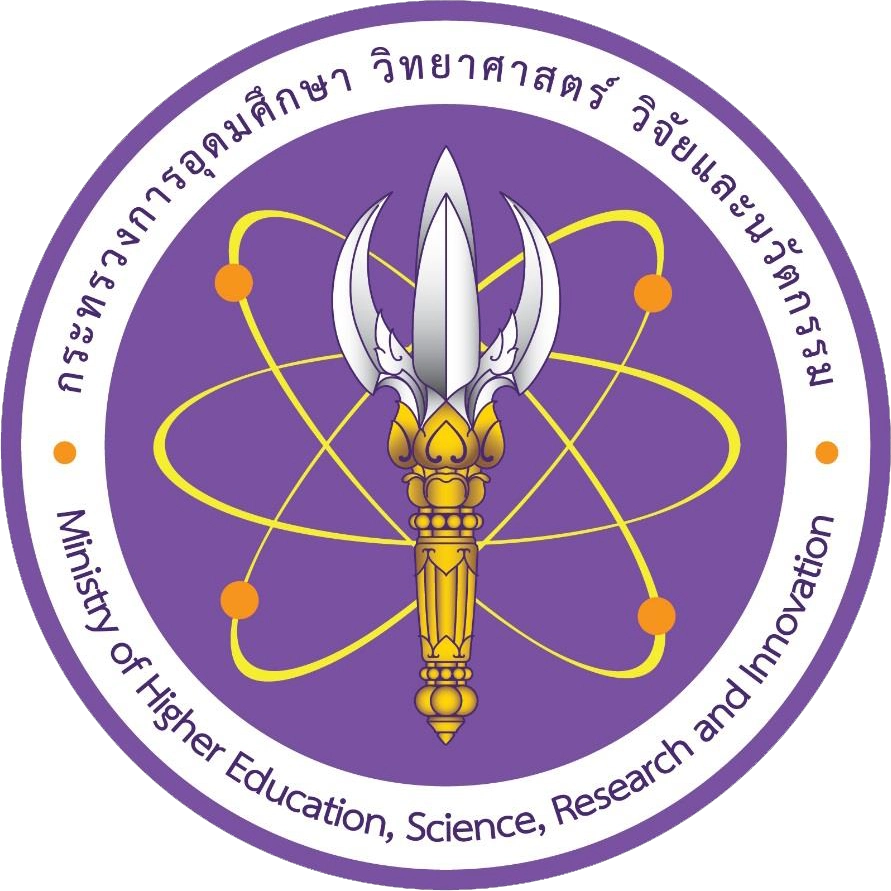ชื่อโครงการ
การวิจัยและพัฒนาด้านข้าวเพื่อการใช้ประโยชน์จากแหล่งพันธุกรรม การผลิตพันธุ์ข้าวปลูกอีสาน การแปรรูปเพื่อเพิ่มมูลค่า การพัฒนาเขตกรรมและวิถีชุมชนคำสำคัญ
ข้าว,Oryza sativa,ข้าวพื้นเมือง,เชื้อพันธุกรรม,ความยั่งยืน,การผลิตข้าว,การเกษตรกรที่สนับสนุนโดยชุมชน,ห่วงโซ่อุปทาน,การพัฒนาที่ยั่งยืน,ตลาดทางเลือก,ผลิตภัณฑ์เวชสำอาง,ผลิตภัณฑ์สปา,ฟิล์มชนิดกระจายเร็ว,ช่องปาก,อาหารสุขภาพเพื่อผู้สูงอายุ,ข้าวอินทรีย์,เศรษฐกิจฐานราก,น้ำเชื่อมจากข้าว,น้ำแป้งพร้อมใช้,เส้นขนมจีน,แป้งทนการย่อย,สตาร์ช,สตาร์ชข้าว,ฐานข้อมูล,เก็บรักษาที่อุณหภูมิต่ำ,ดินเค็ม,ภัยแล้ง,ความเครียดเค็ม,อุณหภูมิสูง,จุลินทรีย์ในดิน,แบคทีเรียทีบริเวณรากพืชที่เป็นประโยชน์ต่อการเจริญเติบโตของพืช,ปุ๋ยจุลินทรีย์,เกษตรปลอดภัย,ฮอร์โมนพืช,ออกซิน,จุลินทรีย์ส่งเสริมการเจริญเติบโตของพืช,โรคไหม้ข้าว,Pyricularia grisea Sacc.,แบคทีเรียปฏิปักษ์,2-Acetyl-1-Pyrroline,ข้าวหอม,ข้าวขาวดอกมะลิ 105,ตัวเร่งปฏิกิริยา,วัสดุคาร์บอนที่มีรูพรุนสูง,ฟางข้าว,โมเลกุลชีวภาพ,ชุดทดสอบนาโนคิทแบบพกพา,สารกำจัดวัชพืช,พาราควอต,ไกลโฟเสท,สารปนเปื้อน,สารสกัดหยาบ,สารสกัดน้ำมันหอมระเหย,การควบคุมแมลงศัตรู,สารกำจัดแมลง,บราสสิโนสเตอรอยด์,ระยะสืบพันธุ์,ผลผลิตข้าว,เซนเซอร์กระดาษ,เส้นใยเซลลูโลส,โลหะหนัก,การควบคุมคุณภาพอาหาร,การตรวจสอบด้านสิ่งแวดล้อมบทคัดย่อ
ชุดโครงการวิจัยด้านข้าวของมหาวิทยาลัยขอนแก่นได้ดำเนินงานการพัฒนาเพื่อส่งเสริมการผลิตและการใช้ประโยชน์จากข้าวพันธุ์ปลูกและพันธุ์พื้นเมืองเพื่อเพิ่มรายได้ให้กับเกษตรกรได้ และลดต้นทุนการผลิตของเกษตรกร โดยผ่านกระบวนการเรียนรู้และเวทีนวัตกรรม ทั้งหมด 5 ด้าน คือ
(1) ด้านเชื้อพันธุกรรมข้าวพื้นเมือง สามารถส่งเสริมการปลูกข้าวเมล็ดฝ้ายซึ่งเป็นการพัฒนาห่วงโซ่อุปทาน ได้ผลผลิตรวม 2.9 ตัน และเกษตรกรที่มีศักยภาพในการผลิตเมล็ดพันธุ์ข้าวคุณภาพดี สำหรับการเก็บรักษาเมล็ดพันธุ์ข้าวพบว่าการนำเมล็ดลงในไนโตรเจนเหลวโดยตรง และการแช่แคลลัสใน PVS3 แล้วเก็บในไนโตรเจนเหลวทันทีจะให้ผลการเก็บรักษาที่ดีกว่า สำหรับวัสดุที่ดีต่อการเก็บรักษาเมล็ดพันธุ์ข้าวหอมมะลิแดง คือถุงอลูมิเนียมฟอยด์ และข้าวธัญสิรินคือ ถุงกระสอบป่าน 2 ชั้น ถุงสุญญากาศ และถุงผ้ามัสลิน 2 ชั้น
(2) ด้านการเพิ่มผลผลิตและคุณภาพข้าว ประกอบไปด้วยการเพิ่มผลผลิตในพื้นที่ดินเค็มพบว่าแบคทีเรียส่งเสริมการเจริญสามารถลดความเป็นพิษที่เกิดจากความเครียดเค็ม และส่งเสริมให้มีผลผลิตเพิ่มขึ้นร้อยละ 6.88-26.93 และส่งเสริมให้ข้าวขาวดอกมะลิ 105 (KDML105) มีปริมาณสารหอม (2-acetyl-1-pyrroline, 2AP) เพิ่มขึ้นร้อยละ 56.73-105.98 สำหรับการเพาะปลูกที่อุณหภูมิสูงพบว่าการให้สารบราสสิโนสเตอรอยด์ที่เหมาะสมส่งผลให้เมล็ดดีต่อรวงเพิ่มขึ้นในสภาพแปลง สำหรับการแก้ไขปัญหาการระบาดของโรคไหม้ข้าวพบว่าแบคทีเรีย E. oryziphilus NP19 ลดความรุนแรงของโรคไหม้ข้าวทำให้มีผลผลิตเพื่มขึ้นร้อยละ 148.92 ที่น่าสนใจคือแบคทีเรียยังส่งเสริมให้ข้าว KDML105 มีความหอมเพิ่มขึ้นร้อยละ 35.20 – 88.74 นอกจากนี้ยังพบว่า สารสกัดสะเดา และสารสกัดแขยง มีแนวโน้มในการควบคุมเพลี้ยกระโดดสีน้ำตาล อีกแนวทางหนึ่งที่สามารถเพิ่มความหอมของข้าว KDML105 คือการฉีดพ่นสารทางใบด้วยน้ำส้มควันไม้ที่เจือจางด้วยน้ำ 1:300 และไฮโดรเจนเปอร์ออกไซด์ความเข้มข้น 1 มิลลิโมลาร์
(3) ด้านการพัฒนาผลิตภัณฑ์มูลค่าสูงจากข้าว สามารถพัฒนาผลิตภัณฑ์รูปแบบเวชสำอางและผลิตภัณฑ์สปาเพื่อใช้ในการนวดบำรุงผิวและประคบ ที่มีมาตรฐานและสามารถจดทะเบียนเพื่อจำหน่ายในเชิงพาณิชย์ เช่น เซรั่มบำรุงผิวหน้า และโลชั่นบำรุงผิวกาย นอกจากนี้ยังได้ผลิตภัณฑ์เสริมอาหารรูปแบบใหม่ที่มีแป้งข้าวดัดแปรเป็นส่วนประกอบสำคัญทำหน้าที่เป็นตัวพา (carrier) สารสกัดสมุนไพร น้ำแป้งพร้อมใช้เพื่อผลิตเส้นขนมจีนเป็นอาหารสุขภาพ ฐานข้อมูล ThRSDB ที่รวบรวมข้อมูลองค์ประกอบโครงสร้างระดับโมเลกุลและคุณสมบัติในการใช้งานของสตาร์ชข้าวไทย รวมทั้งผลิตภัณฑ์จากฟางข้าวคือตัวเร่งประฏิกิริยาเชิงแสงตัวดูดซับที่กำจัดสีย้อมได้สูงมาก โดยมีค่าการกำจัดสีย้อมที่ 614 และ 2628 มิลลิกรัมต่อกรัม สำหรับการกำจัดเมทิลีนบลู และสีย้อมคองโกเรด ตามลำดับ
(4) ด้านการพัฒนาห่วงโซ่อุปสงค์-อุปทาน ของข้าว มีการส่งเสริมเกษตรกรปลูกข้าวในระบบข้าวอินทรีย์และรับซื้อในราคาประกัน เพื่อเป็นวัตถุดิบสำหรับการพัฒนาผลิตภัณฑ์อาหารเพื่อสุขภาพ และผลิตเมล็ดข้าว รวมทั้งส่งเสริมให้มีการจำหน่ายผลิตภัณฑ์ โดยการหาช่องทางการตลาดใหม่ เชิงปฏิบัติการแบบมีส่วนร่วมในการเป็นพื้นที่สร้างการเรียนรู้
(5) ด้านการพัฒนาเทคโนโลยีเซนเซอร์สำหรับ Smart & safe rice farming โดยการสร้างเซนเซอร์วัดสีอย่างง่ายที่อาศัยการรวมตัวของ murexide และ มีไตรเมทิลเตตระเดคซิลแอมโมเนียมโบรไมด์ (TTAB) บนผิวของ ซิลิกาโซลร่วมกับเทคนิคสเปกโทรโฟโทเมทรี เมื่อทำการตรวจวัด Cd2+ ในตัวอย่างข้าว พบว่ามีค่าร้อยละการกลับคืนอยู่ในช่วง 81.02–101.45 และการตรวจหาสารไกลโฟเสทด้วยเทคนิคสเปกโทรโฟโทเมทรี โดยการเตรียมอนุพันธ์กับนินไฮดริน โดยมีโซเดียมโมลิบเดทเป็นตัวเร่งปฏิกิริยา เมื่อนำไปตรวจตัวอย่างน้ำจากแปลงนาข้าว 2 แหล่ง สามารถตรวจพบไกลโฟเสทในปริมาณ 0.016 และ 0.038 ?g/mL ตามลำดับ
Title
Rice Research and Development for the Utilization of Genetic Resources, Value Added Rice Products, Agronomy and CommunityKeywords
Rice,Oryza sativa,indigenous rice,germplasm,sustainability,rice production,community-supported agriculture,supply chain,sustainable development,alternative market,cosmeceutical product,spa product,orodispersible films,oral cavity,healthy food for elderly,organic rice,local economy,rice syrup,rice flour batter,Kanom-jeen,resistant starch,starch,rice starch,database,cryopreservation,saline soil,drought,salinity stress,high temperature,soil microorganism,Plant Growth Promoting Rhizobacteria (PGPR),bio-fertilizer,safe agriculture,phytohormone,Auxin,plant growth promoting microorganism,rice blast disease,Pyricularia grisea Sacc.,antagonistic bacteria,2-Acetyl-1-Pyrroline,jasmine rice,KDML105,catalytic material,highly porous,carbon,bio-based molecule,portable nano kit,herbicide,Paraquat,Glyphosate,chemical contaminant,crude extract,volatile oil,insect control,insecticide,brassinosteroid,reproductive phase,rice yield,paper-based sensor,cellulose fiber,heavy metal,food quality control,environmental monitoringAbstract
Khon Kaen University rice research program has been granted to conduct research to support the development and application of cultivated and indigenous rice Thai rice varieties. This research program will use community-supported agriculture approach to expedite and increase farmer income and reduce cost for rice production. The program has been performed through 5 learning and innovation platforms.
(1) Characterization of germplasm of indigenous Thai rice variety. Approx. 2.9 tons of Malet Phai rice grains were successfully produced. The farmers have improved the skills and techniques for the production of a good quality rice grain. Rice grains have been cryopreserved and soaking rice callus in the PVS3 followed dipping in liquid nitrogen was more effective than a direct dipping of grains into liquid nitrogen. The materials suitable of rice storage bag were aluminum foil for Thai jasmine red rice. While, 2-layer gunny-bag, vacuum bag, and 2-layer muslin were suitable for Thansirin rice.
(2) Improved rice production and quality under saline soil, high temperature and rice blast disease stresses. Plant-growth promoting bacteria (PGPB) reduces salt stress and increased yield of KDML105 rice by 6.88-26.93% and increased aroma (2-acetyl-1-pyrroline, 2AP) by 56.73-105.98%. Brassinosteroids increased the number of complete filled-grains for rice grown under high temperature in the paddy field. For solving the spread of rice blast disease, a PGPB strain namely, Enterobacter oryziphilus NP19 was able to reduce the rice blast disease severity by 148.92% and increased the amount of KDML105 aroma by 35.20 – 88.74%. Moreover, spraying of wood vinegar (1:300 dilutions in water and 1 mM hydrogen peroxide increased a production of KDML105 aroma. For a biocontrol of insect pest in the rice field, neem and rice paddy herb extracts showed trending to control the population of brownplanthopper insect.
(3) Innovation of value-added products from rice. Rice-based cosmeceutical and spa products used for skin massage and compress have been developed to reach the standard level and registered for the commercial scale up such as facial serum and body lotion. In addition, novel rice-based dietary supplement has been developed as the carrier for herbal extract. Rice starch was used for the production of healthy and ready-to-use Kanom-jeen noodles. ThRSDB database has been constructed to collect and analyze the data of structural information and application of Thai rice starch. Rice straw has been tested as photo catalyst which was able to remove methylene blue and Congo red dyes at 614 and 2628 mg/g, respectively.
(4) Development of rice supply-demand chain. We encouraged and helped farmers to produce organic rice and buy at insurance price. The organic rice was promoted and used as a raw material to produce healthy food and seed production. Moreover, new market channels for local economy were opened and expanded for the exhibition and distribution of organic rice-based products. These exhibiting markets will be available for the publics and so the young farmer, public, students have the opportunity to learn, join and share their experiences and skills.
(5) Chemical-based sensor for smart and safe rice farming. Simple and rapid colorimetric sensor for detection of Cd2+ ion has been constructed from the consolidation of murexide and tetradecyl trimethyl (TTAB) on the surface of silica sol and spectrometry. When the paper-based sensor was tested to detect the Cd2+ ion in rice sample, the recovery was relatively high at approx. 81.02-101.45%. For the detection of glyphosate using spectrophotometry, ninhydrin derivative catalyzed by sodium molybdate was able to detect glyphosate in two water samples from paddy field at 0.016 and 0.038 ?g/mL, respectively.


